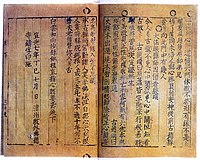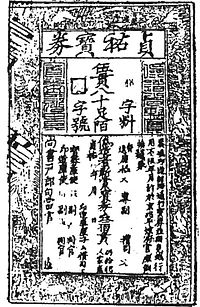|
Vikidia currently has 4,621 articles. Improve it! |
|
Join Vikidia: create your account now and improve it! |
Printing




Printing is putting words and images on paper by mechanical means. Books and newspapers are made by printing. Usually, the images are formed by ink. The ink is put on paper in machines called printing presses.
Printing is one of the technologies which has changed the world. It is an efficient way to multiply writing, so that copies may be made available to many people.
History[edit | edit source]
Writing originated after people had settled in permanent dwellings. It dates from 3,300BC, which is over 5000 years ago. A variety of writing systems were invented, long before paper was invented. Clay, papyrus, wood, slate and parchment (prepared animal skins) have all been used. The invention of paper by the Chinese was a step forward.[2][3][4][5]
Early printing[edit | edit source]
The earliest printing known was in 8th century China and Korea. Whole pages carved on flat wooden blocks were used. Covered with a carbon-based ink, they were pressed onto sheets of paper.
The second stage was to use separate characters by carving or casting. This was done in 11th century China and Korea. It failed to be really successful, because of the structure of the Chinese written language, shared at the time by Korea, which had thousands of characters. Because of this, the method was not significantly better than copying by scribes.[6]
Printing was reinvented in 15th century Europe. Though slow to develop at first, print became the main means of communication between people who wished to record knowledge. It was hugely successful, largely because, with an alphabetic system of writing, print was much more economical than copying, and permitted many times as many copies to be available for readers. It was a revolution which helped all aspects of life in Europe, at a time when Europe was becoming the dominant region of the world.[7][8]
Along with a technology for printing words, there were various means for printing graphics. Carving on blocks of wood and engraving on copper were used up until about 1800. After that, a bewildering array of inventions arrived, including ways to print photographs.[9]
Machines to speed printing, cheaper paper, automatic stitching and binding all arrived in the 19th century during the industrial revolution. What had once been done by a few men by hand was now done by limited companies on huge machines. The result was much lower prices, and a much wider readership.
Print and social change[edit | edit source]
The consequences of print have been considerable. It lead to the spread of knowledge, and had many side-effects. Mainly, it took control out of a small class of clerks (mainly scribes and monks) and put it in the hands of a newly educated readership. Many of the first books were in Latin; some in Greek. The Bible was one of the first books printed. Later, almost all books were printed in the ordinary language people spoke. Science was given a great boost by printing, and scientific ideas are still usually first published in print. Several scholars have thought that print even changed the way people thought.[10][11][12][13]
Related pages[edit | edit source]
References[edit | edit source]
- ↑ Buringh, Eltjo and van Zanden, Jan Luiten 2009. Charting the “Rise of the West”: manuscripts and printed books in Europe, a long-term perspective from the sixth through eighteenth centuries. The Journal of Economic History 69, 2, p417, table 2.
- ↑ Robinson. Andrew 1995. The story of writing. Thames & Hudson, London.
- ↑ Christin, Anne-Marie (ed) A history of writing. Flammarion, Paris.
- ↑ Gaur, Albertine 1992. A history of writing. 3rd ed.
- ↑ Diringer, David 1968. The alphabet: a key to the history of mankind.
- ↑ The earliest printed book with movable type was published in Korea and is known as the Jikji.Memory of the World, unesco.org, accessed November 2009
- ↑ Lefebre L & Martin H-J. 1990. The coming of the book. new ed, London.
- ↑ Martin H-J. 1994. The history and power of writing. Chicago.
- ↑ Bland, David 1958. A history of book illustration: the illuminated manuscript and the printed book. Faber & Faber, London.
- ↑ Olsen, David R. 1994. The world on paper: the conceptual and cognitive implications of writing and reading. Cambridge. 0-521-57558-3
- ↑ Eisenstein, Elizabeth L. 1979. The printing press as an agent of change. 2 vols, Cambridge University Press. ISBN 0-521-21967-1
- ↑ McCluhan, Marshall 1962. The Gutenberg galaxy: the making of typographic man. London: Routledge & Kegan Paul.
- ↑ McCluhan, Marshall 1964. Understanding media: the extensions of man. London: Routledge & Kegan Paul.
Other websites[edit | edit source]
- American Printing History Association - numerous links to online resources and other organizations
- The development of book and printing. English website of the Gutenberg-Museum Mainz (Germany)
- Planet Typography - history of printing - selection of international sites dedicated to the history of printing
- Learn about printing—International Paper
- BPSnet - The website of the British Printing Society
- Children of the Code - Online Video: The DNA of Science, The Alphabet and Printing

|
Visual Arts Portal — All articles about the visual arts! |
